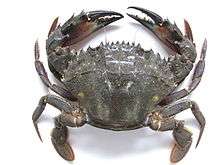Hexapodidae
Hexapodidae is a family of crabs, the only family in the superfamily Hexapodoidea.[1] It has traditionally been treated as a subfamily of the family Goneplacidae,[2] and was originally described as a subfamily of Pinnotheridae. Its members can be distinguished from all other true crabs by the reduction of the thorax, such that only seven sternites are exposed, and only four pairs of pereiopods are present.[3] Not counting the enlarged pair of claws, this leaves only six walking legs, from which the type genus Hexapus, and therefore the whole family, takes its name. Some anomuran "crabs", such as porcelain crabs and king crabs also have only four visible pairs of legs. With the exception of Stevea williamsi, from Mexico, all the extant members are found either in the Indo-Pacific oceans, or around the coast of Africa.[3]
| Hexapodidae | |
|---|---|
| Scientific classification | |
| Kingdom: | |
| Phylum: | |
| Subphylum: | |
| Class: | |
| Order: | |
| Infraorder: | |
| Section: | |
| Subsection: | |
| Superfamily: | Hexapodoidea |
| Family: | Hexapodidae Miers, 1886 [1] |
| Type genus | |
| Hexapus De Haan, 1833 | |
| Genera | |
Fossil record
In addition to the extant taxa, the family contains two genera known only from fossils – Goniocypoda and Palaeopinnixa – and two further genera include both living and fossil representatives: Hexapus and Stevea.[1] The family's fossil record extents back certainly as far as the Paleocene, with unverified reports of a species in the Maastrichtian of Senegal.[3]
Genera
The following are the genera included under Hexapodidae:[3][4][5]
- Genera marked with † are extinct
- †Bellhexapus De Angeli, Guinot, & Garassino, 2010
- †Eohexapus De Angeli, Guinot, & Garassino, 2010
- †Eurohexapus De Angeli, Guinot, & Garassino, 2010
- †Globihexapus Schweitzer & Feldmann, 2001
- †Goniocypoda Woodward, 1867
- Hexalaughlia Guinot, 2006
- Hexapinus Manning & Holthuis, 1981
- Hexaplax Doflein, 1904
- Hexapus De Haan, 1833
- Mariaplax Rahayu & Ng, 2014
- Lambdophallus Alcock, 1900
- Latohexapus Huang, Hsueh, & Ng, 2002
- Paeduma Rathbun, 1897
- †Palaeopinnixa Via, 1966
- Parahexapus Balss, 1922
- Pseudohexapus Monod, 1956
- Rayapinus Rahayu & Ng, 2014
- Spiroplax Manning & Holthuis, 1981
- Stevea Manning & Holthuis, 1981
- Thaumastoplax Miers, 1881
- Theoxapus Rahayu & Ng, 2014
- Tritoplax Manning & Holthuis, 1981
References
- Sammy De Grave; N. Dean Pentcheff; Shane T. Ahyong; et al. (2009). "A classification of living and fossil genera of decapod crustaceans" (PDF). Raffles Bulletin of Zoology. Suppl. 21: 1–109. Archived from the original (PDF) on 2011-06-06.
- Jung-Fu Huang; Pan-Wen Hsueh; Peter K. L. Ng (2002). "Crabs of the family Hexapodidae (Decapoda: Brachyura) from taiwan, with description of a new genus and new species" (PDF). Journal of Crustacean Biology. 22 (3): 651–660. doi:10.1163/20021975-99990277.
- Carrie E. Schweitzer; Rodney M. Feldmann (2001). "Differentiation of the fossil Hexapodidae Miers, 1886 (Decapoda: Brachyura) from similar forms" (PDF). Journal of Paleontology. 75 (2): 330–345. doi:10.1666/0022-3360(2001)075<0330:DOTFHM>2.0.CO;2.
- Dwi Listyo Rahayu; Peter K. L. Ng (2014). "New genera and new species of Hexapodidae (Crustacea, Brachyura) from the Indo-West Pacific and east Atlantic" (PDF). Raffles Bulletin of Zoology. 62: 396–483. Archived from the original (PDF) on 2014-12-15. Retrieved 2014-12-15.
- Antonio De Angeli; Danièlle Guinot; Alessandro Garassino (2010). "New hexapodid crabs from the Eocene of Vicenza (NE Italy) (Crustacea, Decapoda, Brachyura, Hexapodidae)" (PDF). Atti della Società Italiana di Scienze Naturali e del Museo Civico di Storia Naturale di Milano. 151 (1): 51–75.
